

 The South African
The South African
Twenty-five years ago the South African National War Museum first opened its collections to the public. It was not until 25th October, 1946, however, that it was declared a corporate body subject to the State-Aided Institutions Act, thus becoming the first National Military Museum in South Africa. The year 1967 is therefore a momentous occasion in that the Museum is able to celebrate the twenty-fifth and twenty-first anniversaries of these two historic occasions at the same time. It is thus most appropriate that this journal should make its appearance this year.
One of the first steps leading to the establishment of the Museum was taken by Capt. (later Colonel) J. Agar-Hamilton when he was appointed Historian of the Defence Force in 1940 and formed an Historical Records Committee. On 16th July, 1941, this Committee submitted the proposal for consideration by higher authority "that in view of the long South African Military tradition and the need for maintaining a sense of pride in South African military achievements, the Historical Records Committee recommends that steps should be taken to ensure the preservation of documents and materials of military interest." On 6th February, 1942 approval was obtained from the late Field Marshal the Rt. Hon. J.C. Smuts, P.C., O.M., C.H., D.T.D., E.D., in his dual capacity as Minister of Defence and Commander-in-Chief of the S.A. Defence Force. The early collection of exhibits was then brought together by the late Capt. G.C. Shortridge and Captain W.A. Bellwood (still a Trustee today) and displayed at the Liberty Cavalcade at the Zoo Lake; thereafter it was on view in the Public Library building at Johannesburg until 1946 when the Museum moved to its present premises in the Zoological Gardens.
The buildings comprised two Bellman aircraft hangars. In 1947 an army hut was added as office accommodation. These buildings, slightly improved and added to internally, still house the Museum today.
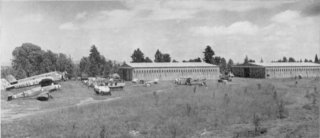
Museum and Grounds when
officially opened in 1947
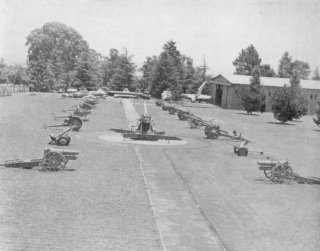
Portion of the Grounds known as "Artillery Row"
The Museum was officially opened by Field Marshal Smuts, on 29th August, 1947.
Considerations of space preclude us from reproducing Field Marshal Smuts's address here. His opening remarks however are well worthy of repetition: "We are gathered here today", he said, "to open what may not unfairly be looked upon as a memorial to the greatest united effort our country has ever been called upon to produce. Memorials, of course, have more than one use they serve to remind us of what is past, of great deeds of heroism and sacrifice; they also serve as a pointer, and sometimes as a warning, to the future ... More than once in our history we have taken up the fight against great odds without counting the cost. It is this stout spirit - the same spirit that animated the Voortrekkers and the Pioneers - that has enabled us to establish a war potential in our country that is, under the circumstances, almost unbelievable ... It is not our habit to boast, but we sometimes need to be reminded of these things ... It is for these reasons that I welcome this opportunity of opening the South African National War Museum."
In his introductory address the late Brigadier the Hon. F.B. Adler, M.C., V.D., E.D., First Chairman of the Board of Trustees, referred to the buildings. His words make interesting reading, "We have had to adapt the hangars to a use for which they were certainly never designed. Consequently we were more than distressed to learn that our presence was distasteful to some good citizens. Admittedly a Bellman hangar is far from being a thing of beauty. It is designed for severely practical use, but the two erected here have solved the problem of a temporary home in a way otherwise impossible of solution, and have enabled us at last to realise the dream of establishing the War Museum entrusted to our care. I do plead with those good citizens to realise how temporary our occupation is and that we as Trustees will never be satisfied till our permanent home is erected and till our needs as a national institution are met by a more suitable and more beautiful building in which to house and display to advantage our exhibits, present and future."
Thus from the start the buildings were unsuitable and as the collections grew became hopelessly inadequate.
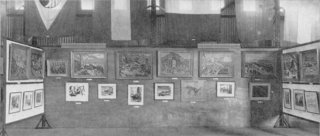
Art Section - 1947
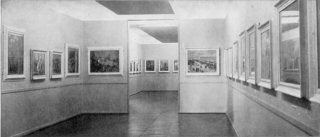
Art Section as it is today [1968]
From the date of its declaration as a State-aided Institution the Museum became eligible for a grant-in-aid, at first from the Department of Interior and from 1st May, 1948, to the present time, from the Department of Education, Arts and Science. A move is at present being made to have the Museum transferred to the Ministry of Defence which department it is felt is rather more appropriate to a military museum.
In the Museum's formative years it was run by an Advisory Committee but on becoming a State-aided Institution a Board of Trustees was appointed, this Board of Trustees being representative of the Ministry concerned, the four Provinces, the three arms of the Defence Force, the Johannesburg City Council, and Donors.
From the outset the displays, built up of items collected mainly from the various battlefields of World War II at a time when a patriotic public wished to preserve something of the deeds of our fighting forces, proved extremely popular. Given ample funds with which to develop the Museum would have expanded at an unprecedented rate but from the outset it was doomed to a frustrating hand-to-mouth existence which continues even today. The Government provided only sufficient funds to pay the salaries of a small staff and certain administrative costs. It was most fortunate that as a State-aided institution the Museum was able to call on the Public Works Department to maintain its buildings and effect certain improvements to them from year to year. There was, however, little hope of building up the displays until the Johannesburg City Council, which had from the start shown interest and a desire to have the Museum established in Johannesburg, came to the rescue and voted an annual grant which has in fact made possible most of the displays and improvements to the exhibitions brought about from year to year.
As the Museum became better known more and more exhibits were donated. However, many fine exhibits offered to the Museum shortly after World War II at prices which it could not afford were lost to other museums, both in and outside South Africa. Despite this drawback the Collections grew and, of necessity, so too did the services offered to the public.
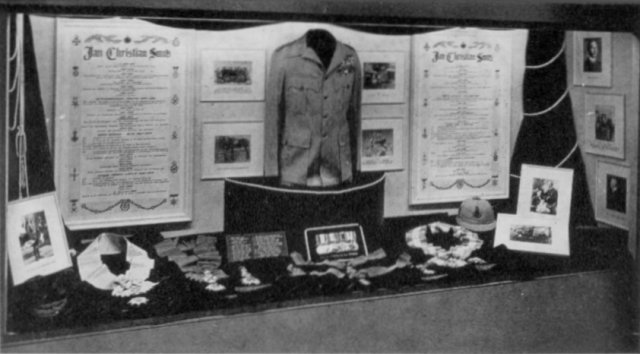
Medals and Uniforms of the late
Field-Marshal J.C. Smuts in the
"Distinguished Soldiers' Corner"
Today the contents of the hangars, now no longer vast corrugated shells but broken down as far as possible into separate galleries, illustrate the weapons with which wars have been fought on land, at sea and in the air. The thousands of exhibits, many of which unfortunately cannot be displayed due to the limited area available, comprise a number of aircraft, tanks, armoured cars, guns and other large items brought back from the battlefields of World War II. For this reason exhibits from the period 1939-1945 predominate and visitors often go away with the impression that the Museum covers only the two World Wars of the Twentieth Century. This is quite wrong - the intention of the founders as recorded in contemporary documents and reflected in the Museum's objects was to provide a visual representation of the Military history of South Africa. South Africa's military strategy and tactics have been greatly influenced by the first and subsequent armed conflicts between white and black and stories of the fortitude of earlier settlers have had a profound influence on succeeding generations. To appreciate the science of war as it is today the student must study the reasons and tactics, strategy and weapons used in previous wars, and some of the battles of the pre-Union period which have had a considerable influence on modern warfare. All that prevents the Museum from building up displays of the early periods is lack of space and funds. The problem of space is in fact so serious that a large number of bulky objects are displayed in the grounds of the Museum. Some, including historically valuable aircraft such as the JU 86, JU 52, Avro Anson and Wapiti as well as a number of vehicles deteriorated to such an extent that it became necessary to scrap them. Every attempt was made to find outside storage but with the exception of three aircraft - Messerschmitt Me-262B; Focke Wulf FW-190A3 and Fieseler Storch, stored by the South African Air Force, free accommodation could not be found and funds would not permit the hiring of the badly needed additional storage. A vast amount of material is, however, held in storage at the Museum. This is a matter of concern to the Trustees for not only is the public being denied access to some of the finest collections in the Southern Hemisphere but the exhibits so stored, in crowded and unsuitable conditions, are deteriorating and will, in some instances, soon be useless for future exhibition.
The solution is obviously a bigger and permanent building. This need has been recognized by the Trustees who, backed by the Hon. Minister of Education, Arts & Science, have launched a national fund-raising campaign for the purpose. A total of Rl,l00,000 is required but it is anticipated that the Government will provide at least 50% of this amount. A good start has already been made and to date R205,000 has been collected. Due to the generous action of the Johannesburg City Council in donating the Museum's present site the new building will be erected adjacent to the existing buildings which will be removed as soon as the transfer of the collections is completed. The design has not yet been determined but it is possible to give an assurance at this time that the building will be worthy of the City and surroundings in which it is to be built. Also that it will depart as far as possible from the present large halls where no strict chronological sequence is possible and where the visitor is faced with the problem of finding his way around and is never certain that he has seen all the exhibits.
Since the Museum first opened over 2,000,000 visitors have passed through its doors - rising from 40,000 in its first year to 173,728 in 1966.
The accompanying pictures illustrate that despite the long uphill financial battles good progress has been made. Public interest in South Africa's Military history has been stimulated by means of many fascinating and unique displays and young and old are able to further their knowledge through the media of the reference library, lectures, films and demonstrations.
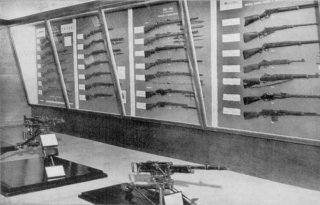
Section of the Rifle Gallery
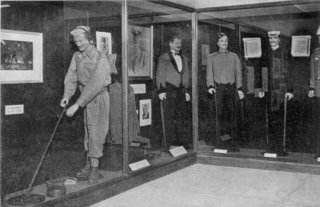
S.A. Engineering Corps Exhibit
The Museum has thus become not merely a place of interest but the storehouse of many of the Nations most precious records and a centre of culture and learning for all who pass through its "portals."
Return to Journal Index OR Society's Home page
South African Military History Society / scribe@samilitaryhistory.org